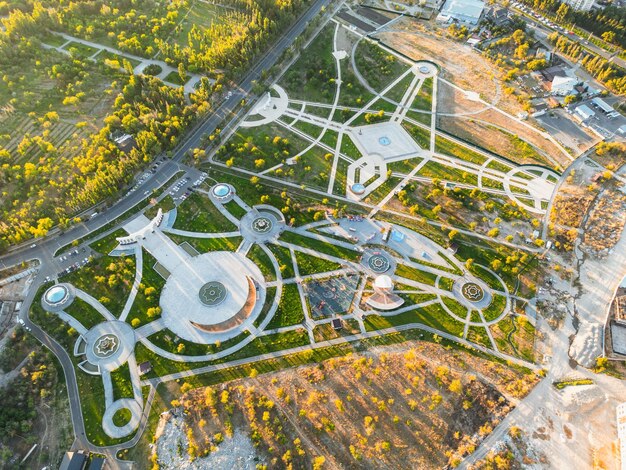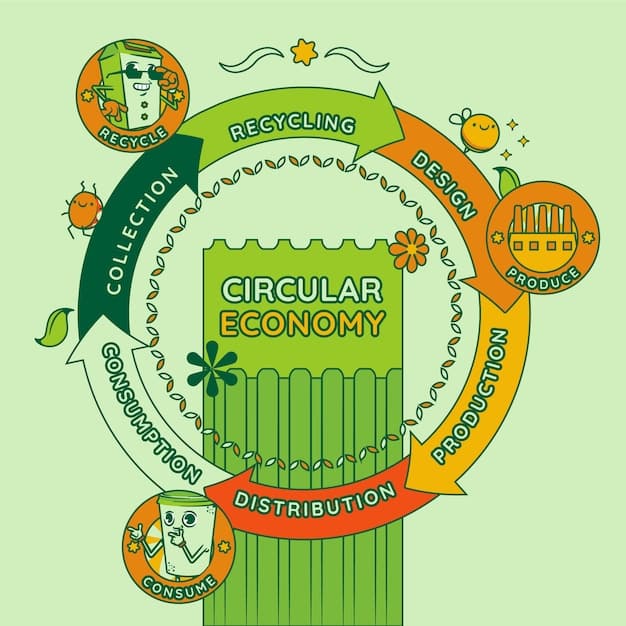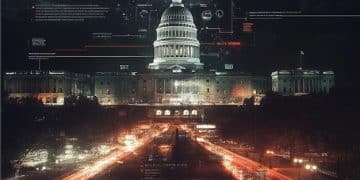US Net-Zero 2050: A Realistic Goal Under Current Policies?

Achieving net-zero emissions by 2050 in the US under current policies presents a multifaceted challenge, requiring substantial policy acceleration, technological innovation, and significant investment across all sectors of the economy.
The ambitious goal of reaching net-zero emissions by 2050 in the US under current policies is a topic of intense debate, central to global climate efforts and the nation’s economic future. As the world grapples with escalating climate change impacts, understanding the feasibility of such a monumental shift is paramount for policymakers, industries, and citizens alike.
Understanding the US Net-Zero Target and its Genesis
The concept of net-zero emissions has gained significant traction globally, representing a critical threshold where human-caused greenhouse gas emissions are balanced by their removal from the atmosphere. For the United States, this commitment marks a pivotal shift in environmental policy, aiming to drastically reduce the nation’s carbon footprint.
The push for net-zero by 2050 is not arbitrary. It stems from scientific consensus articulated by the Intergovernmental Panel on Climate Change (IPCC), which emphasizes the urgent need to limit global warming to 1.5 degrees Celsius above pre-industrial levels to avert the most catastrophic climate impacts. Achieving this requires a rapid and sustained reduction in emissions, with net-zero by mid-century being a key milepost.
The Paris Agreement and US Commitments
The United States formally re-joined the Paris Agreement in 2021, reaffirming its commitment to global climate action. This re-engagement bolstered international efforts and signaled a renewed dedication to domestic emission reduction targets. The Biden administration set an economy-wide target of cutting net greenhouse gas emissions by 50-52% from 2005 levels by 2030, a significant interim step towards the 2050 net-zero goal.
These targets are designed to align US climate policy with scientific imperatives and global expectations. However, targets alone do not guarantee success; the real challenge lies in the implementation of policies that can translate these aspirations into tangible reductions.
- Scientific Basis: IPCC reports highlight the urgency of net-zero.
- International Alignment: US re-entry to the Paris Agreement strengthened global efforts.
- Interim Goals: The 2030 target is a crucial stepping stone.
The genesis of the US net-zero target is deeply rooted in scientific urgency and international cooperation. It signifies a profound understanding that climate change is an existential threat requiring immediate and comprehensive action. The path to 2050, however, is fraught with complexities, demanding an unprecedented overhaul of energy systems, industrial processes, and societal behaviors.
Current Policies and Their Projected Impact
Assessing the feasibility of the US reaching net-zero by 2050 under current policies requires scrutinizing the efficacy and scope of existing legislative frameworks, executive actions, and economic incentives. While significant progress has been made, gaps remain.
Key policies include the Inflation Reduction Act (IRA), which represents the largest climate investment in US history, alongside foundational environmental regulations. The IRA, enacted in 2022, provides billions of dollars in tax credits, rebates, and incentives for clean energy technologies, electric vehicles, and energy efficiency upgrades, aiming to accelerate the transition away from fossil fuels.
The Inflation Reduction Act (IRA) and its Reach
The IRA’s impact is projected to be substantial. It’s expected to drive down renewable energy costs, spur domestic manufacturing of clean technologies, and create millions of green jobs. Modeling from various think tanks suggests the IRA could help the US achieve a 40% reduction in emissions by 2030, close to the stated goal of 50-52%.
However, the IRA’s success hinges on rapid uptake of its incentives and the ability of industries to scale up clean technologies quickly. It also relies on continued state-level initiatives and private sector investment complementing federal efforts.
- Tax Credits: Incentivize renewable energy and EV adoption.
- Domestic Manufacturing: Boosts production of clean tech components.
- Emissions Reduction: Projected to significantly cut emissions by 2030.
Beyond the IRA, other policies, such as EPA regulations on methane emissions, vehicle emissions standards, and investments in carbon capture and storage technologies, contribute to the overall decarbonization strategy. Each policy, individually and collectively, aims to shift the economy towards a cleaner, more sustainable future.
Despite these extensive efforts, many analyses indicate that current policies, while significant, may not be sufficient on their own to bridge the entire gap to net-zero by 2050. There’s a consensus that further, more aggressive policy interventions and technological breakthroughs will be necessary.
Challenges and Gaps in the Current Policy Framework
While the US has implemented significant policies aimed at climate action, several inherent challenges and existing gaps within the current framework pose considerable hurdles to achieving net-zero emissions by 2050. These include political volatility, reliance on market mechanisms, and insufficient focus on hard-to-abate sectors.
One major challenge is the inherent political divide and the risk of policy reversal. Climate policies, especially those impacting energy production and consumption, often become battlegrounds in partisan politics. A change in administration or congressional control can lead to rollbacks or weakened enforcement, hindering long-term planning and investment.

Sectoral Gaps and Technological Dependencies
Certain sectors, often termed “hard-to-abate,” present particular difficulties. Industries like heavy manufacturing (steel, cement), long-haul transportation (aviation, shipping), and agriculture are complex to decarbonize due to their inherent processes and reliance on fossil fuels. Current policies offer some incentives but often lack the comprehensive strategies needed for deep decarbonization in these areas.
Furthermore, while policies encourage renewable energy, the pace of grid modernization and energy storage deployment remains a concern. An intermittent renewable grid requires robust infrastructure and storage solutions, areas where current investment, though growing, might not be sufficient to meet the rapid demand for electrification.
- Political Polarization: Risks of policy instability.
- Hard-to-Abate Sectors: Insufficient strategies for heavy industry, long-haul transport.
- Grid Modernization: Need for faster deployment of storage and infrastructure.
Another critical aspect is the reliance on private investment and technological innovation. While policies like the IRA offer incentives, the actual deployment relies on businesses and consumers making the shift. If a significant portion of the population or key industries resist adoption, or if breakthrough technologies don’t materialize as quickly as needed, progress will lag.
Issues with permitting for new clean energy infrastructure also represent a significant bottleneck. Complex and lengthy approval processes can delay projects by years, slowing the pace of renewable energy deployment, transmission line upgrades, and carbon capture infrastructure development. Streamlining these processes while maintaining environmental safeguards is a fine balance that current policies struggle with.
Role of Technology and Innovation
Achieving net-zero emissions by 2050 is not solely a policy challenge; it is profoundly dependent on technological advancement and widespread innovation. While existing technologies can address a significant portion of emissions, reaching the “last mile” of decarbonization, especially in hard-to-abate sectors, will require breakthroughs and scaled deployment of nascent solutions.
Key areas for technological innovation include advanced battery storage, green hydrogen production, direct air capture (DAC), and sustainable aviation fuels (SAFs). These technologies are currently in various stages of development and commercialization, but their widespread adoption at scale is crucial.
Scaling Up Nascent Technologies
For example, direct air capture, which removes carbon dioxide directly from the atmosphere, holds immense potential for offsetting residual emissions. However, the technology is currently expensive and energy-intensive. Significant R&D investment and policy support are needed to drive down costs and improve efficiency, making it a viable solution for large-scale carbon removal.
Similarly, green hydrogen, produced via electrolysis powered by renewable energy, offers a promising pathway for decarbonizing heavy industry, shipping, and even parts of the power sector. Current production costs are high, and infrastructure for transport and storage is limited. Policies that de-risk investment and incentivize early adoption are essential for accelerating its development.
- Carbon Removal: DAC and other negative emissions technologies.
- Green Hydrogen: Powering hard-to-abate sectors.
- Advanced Storage: Enhancing grid reliability and renewable integration.
The pace of innovation also relies heavily on cross-sector collaboration between government, academia, research institutions, and the private sector. Funding for basic research, pilot projects, and demonstration plants is critical to moving technologies from the lab to commercial viability.
Investment in smart grid technologies, digitalization, and artificial intelligence can also play a transformative role, optimizing energy use, improving efficiency, and enhancing the resilience of the power system. While some current policies foster this, a more strategic and coordinated approach may be necessary to fully leverage these capabilities.
Economic Implications and Investment Needs
The transition to a net-zero economy carries significant economic implications, demanding massive investment across all sectors but also promising substantial economic benefits in terms of new industries, job creation, and reduced health costs. Current policies like the IRA aim to stimulate this investment, but the sheer scale of the transformation is profound.
Estimates vary, but achieving net-zero by 2050 could require trillions of dollars in cumulative investment over the coming decades in renewable energy capacity, transmission infrastructure, electric vehicle charging networks, energy efficiency upgrades, and industrial decarbonization. This scale of investment necessitates both public and private capital.
Job Creation and Economic Growth
A significant economic benefit often cited is the creation of new jobs in the clean energy sector. From manufacturing solar panels and wind turbines to installing charging stations and retrofitting buildings, the transition can be a powerful engine for employment. Policies need to ensure a just transition, supporting workers in fossil fuel industries with retraining and new opportunities.

- Massive Investment: Trillions needed for energy transition.
- Job Creation: New opportunities in clean energy sectors.
- Economic Benefits: Reduced health costs, energy independence.
The economic models behind current policies suggest a net positive outcome for the US economy, with the societal benefits of avoided climate damages outweighing the costs of transition. However, the distribution of these costs and benefits across different regions and socioeconomic groups needs careful management to ensure equity.
Moreover, the cost of inaction on climate change – via extreme weather events, health impacts, and agricultural disruptions – is projected to far exceed the cost of transitioning to a clean economy. Policymakers must continually weigh these long-term economic risks against the upfront investment required for decarbonization.
Current policies provide a strong foundation for mobilizing capital, particularly through tax incentives. However, unlocking the full scale of necessary private investment will likely require further de-risking mechanisms, clearer long-term regulatory signals, and innovative financial instruments to attract capital to nascent clean technologies and large-scale infrastructure projects.
Policy Recommendations and Future Outlook
The journey towards net-zero emissions by 2050 is an ongoing evolution, requiring dynamic policy adjustments and continued commitment. While current US policies lay a foundational groundwork, further strategic interventions will be paramount to bridge the remaining gaps and ensure the ambitious target is met.
One critical area for future policy strengthening is the implementation of a national clean electricity standard. This would mandate a progressive shift towards carbon-free electricity generation, providing long-term certainty for investors and accelerating the retirement of fossil fuel plants. Complementary policies focusing on industrial decarbonization, such as carbon pricing or stricter emissions limits, are also vital for hard-to-abate sectors.
Fostering Innovation and International Cooperation
Investment in research, development, and demonstration (RD&D) of critical emerging technologies, such as advanced long-duration energy storage and direct air capture, must be significantly scaled up. This requires sustained public funding coupled with incentives for private sector engagement. Furthermore, streamlining permitting processes for clean energy infrastructure is essential to accelerate deployment.
- Clean Electricity Standard: Mandating carbon-free power.
- Industrial Decarbonization: Tailored policies for heavy industry.
- RD&D Investment: Scaling up breakthrough technologies.
Engaging in robust international cooperation is also key. The US can leverage its diplomatic influence to encourage stronger climate action globally, share best practices, and collaborate on technological solutions. Trade policies and supply chain resilience initiatives can also support the transition by ensuring access to critical materials and components for clean technologies.
Moreover, policies that address climate adaptation and resilience alongside mitigation efforts will be increasingly important. As climate impacts intensify, protecting communities and infrastructure from floods, wildfires, and extreme heat becomes a complementary but necessary component of a comprehensive climate strategy.
The future outlook suggests that while the US is moving in the right direction, current policies alone may not guarantee net-zero by 2050. The gap between current trajectory and the 2050 goal is narrowing but still exists. Achieving the target will necessitate a continuous effort to implement more aggressive and comprehensive policies, foster rapid technological advancement, and cultivate sustained bipartisan political will.
| Key Point | Brief Description |
|---|---|
| 🎯 Policy Foundation | The IRA sets a strong base, but further action is needed to meet 2030 and 2050 targets. |
| ⚙️ Technological Reliance | Achieving net-zero depends on scaling up emerging tech like DAC and green hydrogen. |
| 💰 Investment Scale | Trillions in public and private investment are required for the energy transition. |
| 🤝 Political Will | Sustained bipartisan support is critical for long-term policy stability and implementation. |
Frequently Asked Questions
▼
Net-zero emissions refers to the point where greenhouse gas emissions human-caused emissions are balanced by their removal from the atmosphere. This means reducing emissions as much as possible and offsetting the remaining, unavoidable emissions through carbon removal technologies and natural solutions like reforestation. It’s a critical target to limit global warming.
▼
The IRA is pivotal for US climate action, offering significant tax credits and incentives for clean energy, electric vehicles, and energy efficiency. It aims to accelerate the transition away from fossil fuels, drive down clean technology costs, and is projected to help the US achieve substantial emissions reductions by 2030.
▼
Hard-to-abate sectors are industries that are particularly challenging to decarbonize due to their inherent processes and reliance on fossil fuels. These include heavy manufacturing (like steel and cement production), long-haul transportation (aviation and shipping), and agriculture. Significant technological breakthroughs and targeted policies are needed for these areas.
▼
Integrating large amounts of intermittent renewable energy like solar and wind into the grid creates challenges for stability due to their variable nature. This necessitates advanced energy storage solutions, such as large-scale batteries, and significant upgrades to grid infrastructure to ensure reliable power supply and prevent blackouts.
▼
Sustained political will is crucial because achieving net-zero by 2050 requires long-term, consistent policy implementation and substantial investment. Without bipartisan support and stable policy frameworks, climate initiatives risk being reversed or weakened with changes in administration, undermining the predictability needed for private sector investment and technological scale-up.
Conclusion
The question of whether the US will achieve its goal of net-zero emissions by 2050 under current policies is complex, marked by both substantial progress and significant hurdles. While the Inflation Reduction Act and other existing measures have laid a critical foundation, analyses suggest that additional, more aggressive policy interventions, coupled with rapid technological innovation and sustained bipartisan political will, will be indispensable. The economic implications are vast, promising new industries and jobs, but requiring unprecedented levels of investment. Ultimately, the path to net-zero is not fixed; it is a dynamic journey that will demand continuous adaptation, collaboration, and a unwavering commitment from all sectors of society to secure a sustainable future.





